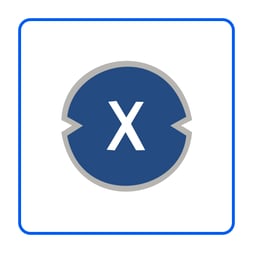Everything you need to know about the XDC Network
- September 07, 2022
-

Written By Troy S. Wood
- Type: Blog
- Content Tags: ISO 20022, R3 Corda Bridge, XDC Network

Well, almost everything you need to know, or else this write-up would be long enough to fill a book.
That said, the important basic information and facts are covered here, which is plenty to get a good handle on one of the top performing and most robust blockchain protocols available.
Blockchain, introduced in 2009 via the Bitcoin protocol, is a decentralized and distributed digital ledger that is used to record transactions. It has gone from an experimental technology to something that is being enmeshed in the fabric of finance and culture, and finally gaining mass attention and global adoption.
With each new iteration of blockchain, a distributed ledger technology (DLT), the industry has improved speed and functionality, advanced new use cases, and solved a number of challenges (often while creating some new ones along the way, like legalization and regulation).
Progression of Blockchain
Blockchain 1.0:
-
-
-
- Bitcoin and proof of work (PoW). This protocol is highly secure due to the difficulty, and large amount of power, required for miners to confirm transactions. As long as 51% of this mining power is honest, the network will work. The tradeoff is that PoW is extremely inefficient.
-
-
Blockchain 2.0:

-
-
-
- Ethereum and programmable smart contracts. this design maintains the security of Blockchain 1.0 but adds a programmable platform - allowing general purpose software programs to be implemented atop the blockchain.
-
-
Blockchain 3.0:
-
-
-
- This advancement brought Proof of Stake (PoS), which involves holders of pre-mined tokens creating nodes that validate transactions. PoS protocols focused on scaling the problem of blockchains, improving latency by many orders of magnitude. As PoS does not involve mining, it is much more energy efficient than Proof of Work.
-
-
In the first and second versions of blockchain technology, advances in decentralization, Proof-of-Work (PoW), and smart contracts have put industry pros in a position where scalability, speed, and interoperability are already helping them to meet their lofty objectives. Now in its third generation, blockchain technology is revolutionizing digital processes and capability in a significant manner.
For example, the XDC Network’s mainnet was officially launched on June 1, 2019. Co-founded by Ritesh Kakkad and Atul Khekade, it uses third-gen tech to power seamless transactions across its blockchain ecosystem, allowing for real-world use cases and improved performance. How does it work? Let’s get into the details.
What is the XDC Network?
The XDC Network (formerly called XinFin) is a Layer 1 blockchain network. A highly optimized, bespoke fork of Ethereum and enterprise-grade protocol, the XDC Network reaches consensus through a customized delegated proof-of-stake (XDPoS) mechanism, which allows for significant scalability and extraordinary processing speed.
Secure, scalable, and highly efficient, the XDC Network is considered a “green project,” as it uses roughly 1% or less of the required energy that traditional PoW blockchains use. It was built from the ground up for the purpose of bridging the gap between centralized finance and DeFi — from the outset, it was designed to meet and exceed the security, speed, cost, and compliance requirements of traditional banking and financial institutions.
How does the XDC Network operate?
The XDC Network uses a Proof-of-Stake method rather than the PoW consensus. For high security and safety, a pool of KYC (Know Your Customer) verified validating nodes are responsible for creating new blocks and preserving the XDC Network’s blockchain.
These institutional and community supported custodians help preserve the integrity of the XDC Network, promote good governance, and maintain operations for Layer 2 dApps and the rest of the network's ecosystem.
What is the XDC coin?

The XDC Network’s native coin is $XDC (XinFin Digital Contract), which is the primary digital asset of the blockchain platform. A key element of the network’s ecosystem, the XDC coin is used as a payment asset, a store of value for investment opportunities as a speculative asset, and to coverthe network’s gas fees for sending $XDC. The coin is also used to create, move across the network, or burn XRC-20 tokens or XRC-721 NFTs, and to create or manipulate a smart contract.
XDC crypto can be procured from various exchanges (e.g., Kucoin, Gate.io, Bitfinex, Bitrue, Bittrex, Liquid) and can be stored in both non-custodial digital wallets (e.g., Guarda Wallet, FreeWallet) and with trusted institutional-grade custodians (e.g., Copper, Bitpanda, Propine, Fireblocks).
What makes the XDC Network unique?
The network’s protocol technology addresses issues of scalability, operational integrity, and interoperability of previous generations, and builds upon existing technologies to create a system on which legacy banking and financial institutions can rely.
Here are just a few things that set this Layer 1 blockchain apart from other blockchain protocols:
Designed for enterprise finance – The XDC Network has been explicitly architected and developed for enterprise-grade finance, with a focus on trade finance, financial messaging, and direct access to R3’s Corda platform at its core. Yet, the network also has plenty of utility for the retail community.
KYC and staking enforcement – All validating nodes (master or standby) that run the XDC Network require 10MM XDC to be staked, as well as submission of KYC documentation, which reduces the risk of bad actors negatively impacting the ecosystem.
High level security – The software has built-in forensic monitoring for bad actors, as well as commercial-grade security provided by the Blockchain Intelligence Group and BitRank VerifiedⓇ software that’s trusted by banks, law enforcement, and governments to prevent fraud.
Fork of the Ethereum protocol – The XDC Network has all the benefits of Ethereum’s blockchain, but is significantly improved for performance, and is considered an EVM (Ethereum Virtual Machine) compatible network. In layman’s terms, that means Layer 2 dApps running on the Ethereum blockchain can easily be ported over to the XDC Network, allowing for significantly improved performance, better security, and significantly lower transaction cost.
The XDC Network protocol team also believes in continuous improvement. In August 2021, Hash Laboratories (who assist with the network’s protocol development) published a paper titled, “Accountability and Forensics in Blockchains: XDC Consensus Engine DPoS 2.0” to define the next network protocol upgrade. The XDC Foundation calls it blockchain 4.0! The most recent network upgrade proposal is highlighted on xdc.dev.
The XDC Network has been explicitly architected and developed for enterprise-grade finance, with a focus on trade finance, financial messaging, and direct access to R3’s Corda platform at its core. Yet, the network also has plenty of utility for the retail community.
Strategic and robust benefits of the XDC Network include:
Super-fast transaction (block) time – Only 2 seconds! Click the button, refresh the screen, and the transaction has already taken place.
Respectable scalability – The network can process upwards of 2,000+ transactions-per-second (TPS).
Near-zero gas fee for transactions – On average, the cost (gas fee) to move $XDC or XRC-20 tokens or to interact with a smart contract on the network is around $0.00001.
Smart contract capability – Through smart contracts, code is built into the protocol which triggers when predefined conditions are met, thus automating a specific workflow and bringing tremendous value and functionality to business software use cases.
XRC-20 Tokens – Projects that build on the network, called Layer 2 projects, usually create their own token or tokens via a smart contract, after which they can control how many tokens are created and how many are burned. These tokens can be traded on the open market or sent person-to-person.
XRC-721 NFTs – Non-fungible tokens are tradable digitized assets that can link ownership to unique physical items such as digitized invoices, artwork, real estate, and more. Currently, there are several consumer NFT marketplaces, including XDSEA, XDCNFT, and SuperBullsNFT.
Interoperability Bridge – Via the WanBridge, digital assets, like bitcoin, Ethereum, XRP, and stable coins like USDC or USDT can be move from their respective blockchains to the XDC Network as wrapped tokens, and when desired, can be sent back to their original chains again.
See the XDC Network nodes in action!
Tools and resources for the XDC Network
Apothem Test Network – A testing platform that mirrors the XDC Network’s protocol, so that software development can be tested and perfected there before the software is released to the production environment on XDC Network’s mainnet.
Block Explorer - An online visualization tool that allows for real-time blockchain viewing as well as searching historical data about transactions, wallet addresses, transaction fees, and more. Currently there are several versions: XinFin Scan and BlockScan.
XDC Network Stats – A powerful analytics platform to view and explore real-time network activities and information of the nodes running the XDC Network.
Utility dApps on the XDC Network
Following are just a few examples of utility dApps on the XDC Network:
Tradeteq - Together with the XDC Network team, Tradeteq created the world’s first trade finance-based non-fungible token (NFT) transaction, as well as the first ever fully regulated, trade finance-backed fungible security token, TRADA.
ComTech Gold – The digitization of gold is redefining the tokenization infrastructure by using blockchain technology that allows both institutional and retail communities to get access to gold electronically, anywhere across the globe.
ChainFiles – Digital notarization is one of blockchain technology's best use cases because of its immutability and timestamping accuracy.
LedgerMail – This decentralized email service combines blockchain, XDPoS consensus, cryptographic algorithms, and a zero-trust mechanism with the mission of protecting the digital rights of email users in a decentralized manner and replacing traditional email transfer protocols like IMAP/SMTP.
Prime Numbers – This decentralized autonomous organization (DAO) generates scholarships for students and our community through NFTs and DeFi.
Wait, where does Impel fit in?
Impel uses the XDC Network’s blockchain to provide two key service offerings:
ISO 20022 Financial Messaging
Impel offers an API that sends ISO 20022 compliant financial messages at a significantly lower cost than traditional legacy providers. Impel also offers high security with its proprietary Layer 2 security module, that hides data from prying eyes while moving from point a to b.
In addition, Impel provides optional functionality for instant settlement. Rather than using the Central Banking system and nostro/vostro accounts, digital assets (including XDC or XRC-20 tokens like wrapped BTC, USDC, USDT or XRP) can be used as collateral if included in the message’s payload for instant settlement.
Want to learn more? Try Impel’s self-paced ISO 20022 demo.
R3 Corda | XDC Network Bridge
Impel offers a new way to settle financial obligations, such as contracts “on chain,” rather than traditional methods outside of the R3 Corda platform.
Send and receive digital assets (cryptocurrency), like XDC, or XRC-20 tokens, like wrapped BTC, USDC, or others, to and from the XDC Network via Impel’s bridge. Connect your company’s CordApp to Impel’s bridge for streamlining business activities.
Learn more by watching the short demo walkthrough below:

Written By: Troy S. Wood
CEO & Founder at Impel a Blockchain FinTech



